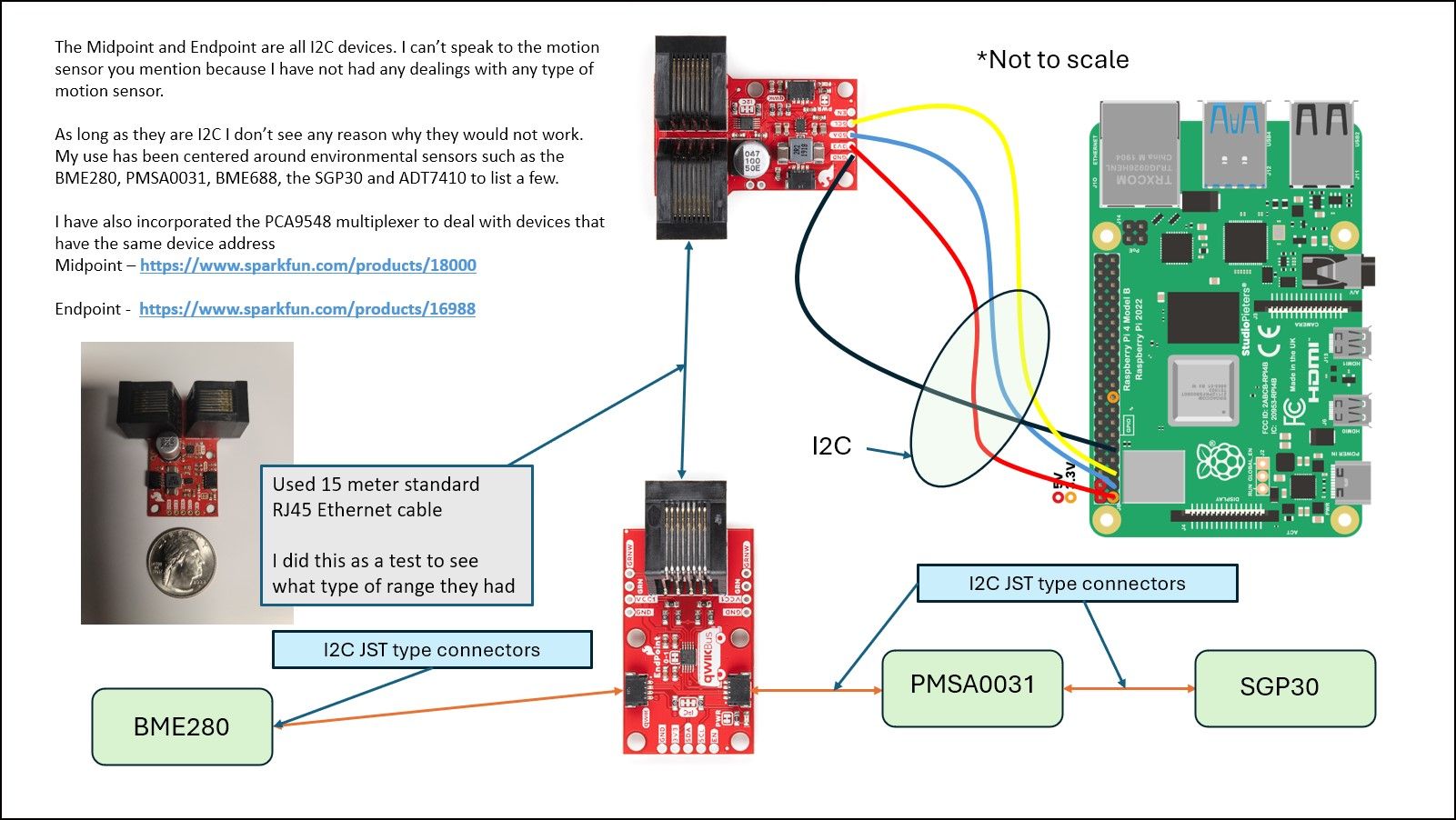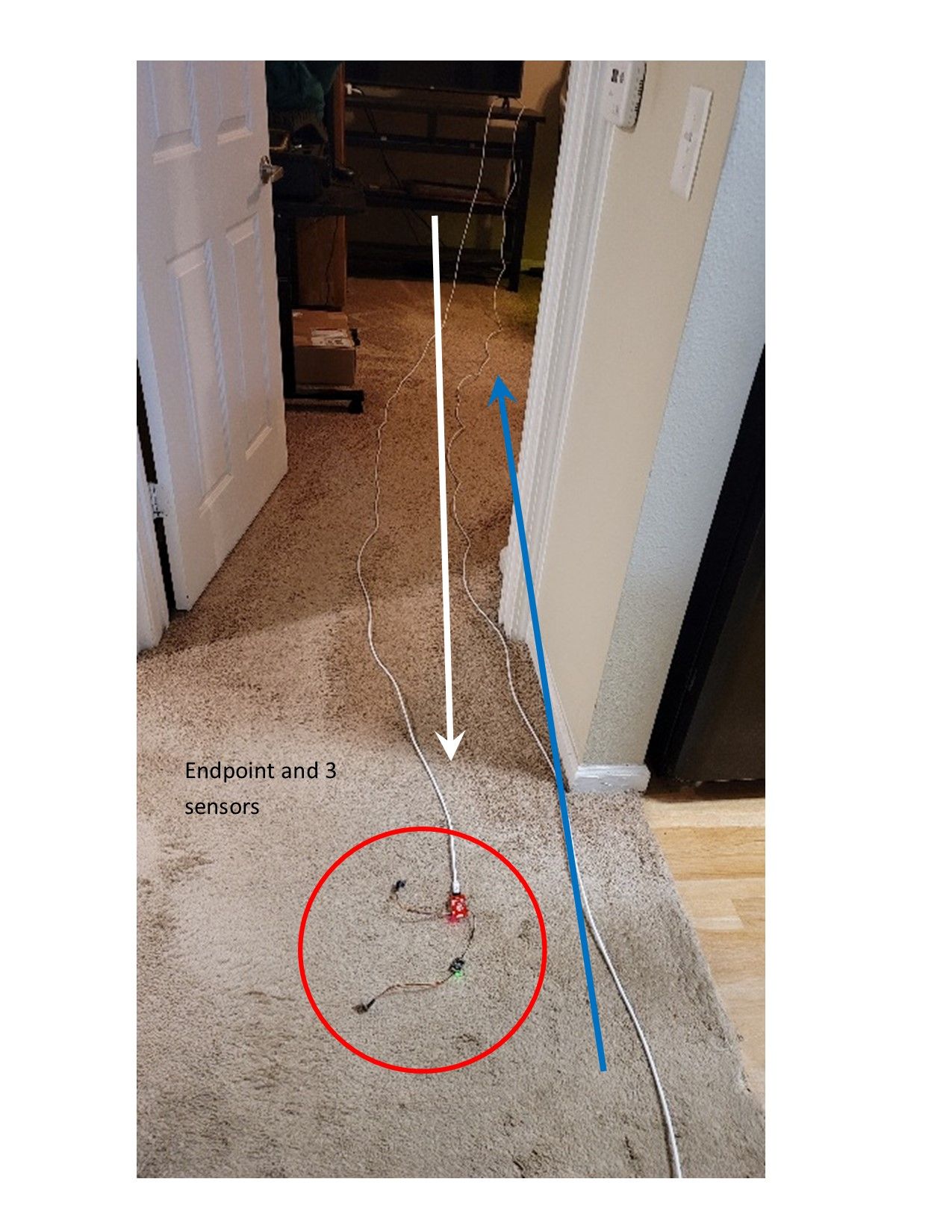Read the statement by Michael Teeuw here.
Endpoint/Midpoint as part of project
-
A member of the MM community asked me about long runs between a sensor and a Pi if I remember the original question correctly. I had already assembled a project doing just that using Sparkfun Midpoint and Endpoint connections. They are part of the Qwiic "ecosystem but they work real well. As a trial a had a 50 ft length of standard ethernet cable plugged it in as shown and then hung several environmental sensors at the far end using Qwiic cables coming of the Endpoint.
I refer to the wiring between instruments as “Jst TYPE” because I can’t keep up with all the various proprietary and industry standard connections in the market these days. There are different lengths of those Qwiic<–>Qwiic cables out there and have bought cables from both reputable venders and Amazon. Not entirely unexpected but have had a few of the Amazon cables that were bad.
There was a question about could you get away with just buying an Endpoint and as I recall, Sparkfun says no. I think the reason has to do with you require a termination but not being a network person that is beyond my knowledge of setting up networks.
-
Thanks @ankonaskiff17 for your description and sketch…very usefull!
My problem is on “Seeed Grove - Gesture V1.0 (PAJ7660)” sensor due to the cable lenght.
With the your enviroment, from the Endpoint, I should connect with my “Grove - Gesture Sensor” and I should solder a piece of cable with the “JST” connector at the end.
I have two questions:
1- which type of “JST” connector is on the Endpoint board?
2- probably this cable is good (I have to cut the Female Jumper in order to solder the cables from “Grove - Gesture Sensor”), correct?I hope I was clear.
-
From the SparkFun website: “All Qwiic-enabled boards use a common 1mm pitch, 4-pin JST connector.”
-
@Egnos The Endpoints and Midpoints are the devices that boost the I2C signal because according to what I have read I2C by itself is distance limited.
You buy the Endpoints and Midpoints to give you the distance capability. I’m not advocating Endpoints and Midpoints because of the JST connectors.Your original question was to the effect “I have this gesture sensor but I also have a distance requirement that I2C alone can’t handle” or words to that effect.
I suggested you look at the Sparkfun Endpoint and Midpoints because that is what their function is.
The best I have to offer is that I took a Raspberry Pi 4B, wired a Sparkfun Midpoint right next to the Pi. On a plastic panel, so the Midpoint was maybe 2 inches (50 mm) from Pi.
I plugged a 50 ft (15 meter) standard ethernet cable into that Midpoint.
I then took a Sparkfun ENDPOINT and plugged it into the far end of the ethernet cable. I connected 3 sensors to Endpoint.As far as Seeed/Grove it says it is I2C on your link but I have no experience with the brand and connection other than I think the Grove connection, may be proprietary. That is inconsequential though as you can get the Qwiic sized JST and splice the connector.
When I first got the hardware I wanted to test the distance claim so slapped together the setup outlined above.
All I can say is that the Midpoint and Endpoint purpose is to give you the distance. I have attached a picture of my ad-hoc test. The Raspberry Pi + Midpoint are another 10 - 15 ft beyond the tail of the blue line. That blue line and white line are the 50’ of ethernet cable and red circle is Endpoint and 3 sensors which are all Adafruit I2C. I want to reiterate that my experience is with Adafruit and Sparkfun sensors and as a general rule those are the only brands I buy so can’t vouch for other brands. In the past I have bought sensors from other companies that advertise as I2C but are really SPI .
These companies will put their brand stamp on their connection by giving it a name such as “Qwiic Connector” or “Grove Connector” but they appear to be JST connectors except Grove may be proprietary.
The easiest way out is to buy this cable but it is dependent on you buying a Midpoint and an Endpoint from Sparkfun. I’m no expert but I know of no other way to push that I2C signal a longer distance.
If Grove is Seeed Studio’s proprietary connector you have to see if Seeed Studio has a solution for pushing I2C long distances and commit to using all Seeed Studio components. The other option is to get the parts I have provided links to.
